by Julie Pigott Dillard | Jun 22, 2018
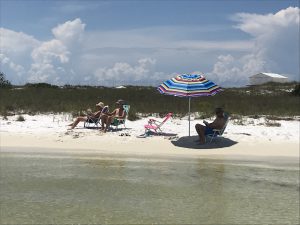 DID YOU KNOW that the sunniest place in Florida is Apalachicola? It sees an average of 241 days with sun…just one of the many reasons I love calling the Florida panhandle my home. I’m not exaggerating when I say I love being outdoors in the sun – going to the lake, fishing in the bay, kayaking down the creek, mowing the grass, picking blueberries, reading a book – I don’t want to imagine living anywhere else.
DID YOU KNOW that the sunniest place in Florida is Apalachicola? It sees an average of 241 days with sun…just one of the many reasons I love calling the Florida panhandle my home. I’m not exaggerating when I say I love being outdoors in the sun – going to the lake, fishing in the bay, kayaking down the creek, mowing the grass, picking blueberries, reading a book – I don’t want to imagine living anywhere else.
Along with my love of the sun comes the need for protection from its harmful rays. I’ve had my share of sunburns and learned the hard way how uncomfortable they can be. Sunburns happen quickly on summer days when the sun is closer to the earth – within the first 15 minutes of exposure. So check out these home remedies and tips to soothe your scorched skin when you’ve overdone it in the sun.
SOOTHE YOUR SCORCHED SKIN
- Take a cool shower or bath to calm your skin.
- Pour apple cider vinegar, witch hazel or cool milk on a soft cloth and gently apply to your sunburned skin.
- Add a cup of apple cider vinegar to a cool bath.
- Chill cucumbers, mash them into a paste and apply to a sunburned face.
- Drink lots of water to re-hydrate your body.
- Take an over the counter pain medicine like ibuprofen or naproxen.
RE-MOISTURIZE and RE-HYDRATE
Once you’ve soothed your aching skin, be sure to frequently re-moisturize your skin with aloe vera gel, petroleum jelly, coconut oil or lotions containing aloe vera or dimethicone. My brother, who is quite fair complected, even keeps aloe vera gel in the refrigerator. If your skin peels or blisters, leave it alone and allow it to heal! Never pick at or further peel your sunburn and certainly don’t pop blisters. Re-moisturize, cover your skin, allow it to heal and continue to drink plenty of water.
LIVING HEALTHY
In 4-H, we believe in living healthy and equipping our youth with the knowledge and skills to prepare them physically, emotionally and socially to meet life’s challenges. To learn more about participating in 4-H healthy living projects, visit the Florida 4-H Projects Page or contact your local UF/IFAS Extension office.
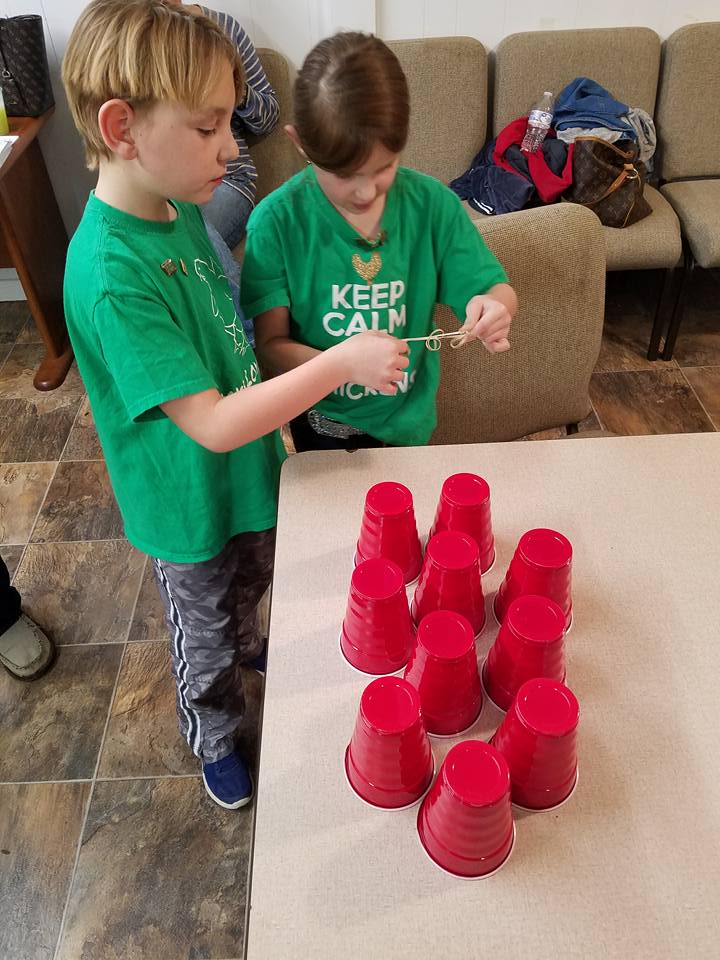
by Rachel Pienta | Jun 15, 2018
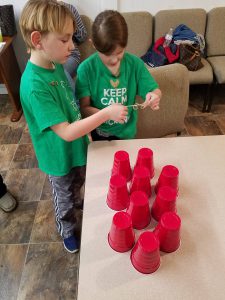
4-H members play the stacking game at a club meeting.
Summer is here, and I’m picturing long and lazy sunny days at the lake or beach. In Florida, the warm, sunny days of summer also bring afternoon thunderstorms and the possibility of tropical storms and occasional hurricanes.
What to do on rainy summer days?
During the summer months, the days of sunshine may be interrupted with periods of rainy weather. For children, rainy weather often means long hours spent inside the house. While some children welcome rainy days to spend time curled up with a book, reading for hours at a time will not occupy every child.
For parents looking for indoor activity options for children beyond movie marathons and video games, using household items already on hand can provide fun alternatives to endless screen time.
STEM CHALLENGE AT HOME
A fun activity that only requires string, rubber bands, and sturdy plastic cups will challenge your children to work together and think creatively to problem solve. The “Stack ‘Em Up: Introduction to Engineering Activity” challenges children to think like engineers. The activity is best done with 4 to 6 children. This is a great activity for children to enjoy when the neighborhood group converges on your house for a rainy afternoon! A complete instruction guide for this activity is included in the links below this article.
HOME KITCHEN CHALLENGE
A number of popular television cooking shows involve challenge competitions with special or limited ingredients. Parents can adapt this concept to help their children develop basic cooking skills while also giving them an opportunity to be creative and problem solve. This “do it yourself” at home cooking competition, adapted from PBS Kids, offers an easy fun way to engage children in creative kitchen fun:
• Divide the kids (or kids and adults) into 2 or 3 teams of 1 – 2 people.
• Gather a set of cooking items for each team – utensils, measuring instruments, bowls, etc.
• Choose an adult or older child to be the judge and/or the announcer/assistant. The judge can also decide on the “Secret Ingredient” that will be revealed to the contestants. Consider making it a fruit, a raw vegetable like carrot, cucumber, or celery, a grain item such as bread or cracker, or a spice like ginger or cinnamon.
• Set up individual or team “cooking stations”. Your cooking competition may be preparation only – without a stove, microwave, or oven.
Plan in time for taking turns cooking if your items will need to be heated or if appliances such as blenders or stand mixers will be used.
To add an additional layer of challenge, parents can decide to limit each time to one preparation method for individual teams or across all teams.
• Decide ahead of time how many additional ingredients competitors may “shop” for in the kitchen.
• Designate a separate spot for the judge or multiple judges to taste the food. This station should be equipped with a plate and eating utensils, and a palate cleanser like water or crackers. For more fun possibilities, create scoring cards with categories for taste, originality, good humor or sportsmanship, and presentation.
• Use a timing device like a kitchen or cell phone timer to add in the time element to the challenge. The suggested competition time is 20 minutes. The 20-minute time should include the child’s recipe planning time. Decisions will need to be made quickly!
• When time’s up, have each team present their creation to the judge, including a verbal description of flavors and the preparation technique. The judge(s) can taste each one and fill out the scorecards.
• Need ideas for prizes? Consider awarding a new cooking utensil like a colorful spatula with a certificate or card declaring the winner(s) “Master(s) of the Grand Spatula!”
• Want to involve additional older children or adults? Designate reporters to videotape and interview the contestants. Extend the fun by watching all the videos once the competition ends or before the winners are announced.
WHEN IT RAINS, GROW CREATIVE FUN FAMILY TIME AT HOME
The next time the summer forecast calls for rain, be prepared with these “rainy day” activity ideas. For more ideas, please contact your local UF/IFAS Extension Office.
How to Create a Cooking Challenge for Kids
How to Host a Cooking Competition for Your Kids
Stack ‘Em Up Activity
http://ngcproject.org/sites/default/files/9.6_stack_em_up_activity.pdf
https://www-tc.pbskids.org/fetch/games/activities/pdf/FETCH_StackEmUp.pdf
by bestevez | Jan 11, 2018
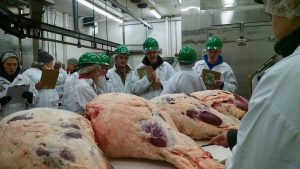
Florida 4-H members judge beef rounds at the UF/IFAS Animal Science Department meat science clinic. Photo Credit: Brian Estevez, UF IFAS Escambia County
Florida 4-H provides learning opportunities, camps, contests, shows and events in a multitude of areas for its members. The 4-H meat science project allows youth to learn about the different cuts of meat including quality factors that affect the safety and taste of the meat products we consume. The project culminates each year in April at the Florida 4-H Meat Judging Contest. The 2018 contest is April 21, 2018 at the Meat Processing Center at the University of Florida. The UF/IFAS Department of Animal Sciences also hosts a Livestock/Meat Judging Clinic on January 12-13 in Gainesville to prepare 4-H and FFA members for the contest.
What is 4-H Meat Judging?
Many Florida 4-H members are already in the production of meat products through exhibiting market steers, swine, sheep, and goats at livestock competitions. Through participation in judging contests and other leadership contests, agents, leaders, and youth learn valid, science-based information to consider when evaluating and making decisions, as well as learning proper meat storage and handling procedures. This knowledge and expertise to purchase safe, nutritious meat products gives future agricultural and food industry leaders a broader view of the livestock industry.
The 4-H Meat Judging Contest is composed of three areas, retail cut identification, carcass, wholesale, and retail placing classes, and oral reasons. 4-H members have to identify 50 retail cuts, including the species, primal, retail name, and cooking method. Youth then have to rank eight placing classes (carcass, wholesale, and retail classes). Finally youth have to give two sets of reasons on the placing classes that they have ranked.
This project area helps youth improve life skills, such as decision making, communications skills and confidence, but it also provides them a very practical skill they can use every time they visit the grocery store or butcher shop. Youth learn how to examine a cut of meat to determine which will be of the highest quality and flavor. Whether they cook for themselves or others, this useful skill will be perfected over time.
Another exciting aspect of the Florida 4-H Meat Judging Contest is the opportunity to attend National 4-H Meat Judging Contests. The first place senior team earns a trip to Kansas State University to participate in the National 4-H Meat Judging Contest as part of the American Royal Livestock Show in Kansas City. The second place senior team earns a trip to Denver to participate in the National Western Roundup Meat Judging Contest as part of the Western National Livestock Show.
In addition to the meat judging contest, Florida 4-H offers the Hog and Ham program and the Florida 4-H Tailgate Contest:
The Florida 4-H Hog and Ham Program is a statewide 4-H program which takes the participant through the total process of pork production from beginning to end. Youth select a feeder pig and grow it to harvesting weight, all the while keeping records on feed amounts and costs, health care, expenses, weights, etc. Youth harvest the hog and process it into wholesale or retail cuts. The project concludes by participating in a retail comparison project, completing a record book, and presenting a demonstration or illustrated talk to the other participants.
The Florida 4-H Tailgate Contest was created to further enhance the 4-H meat project by allowing youth to demonstrate their food and fire safety, meat selection, and outdoor cooking skills. Youth grill one of four proteins: beef, pork, poultry (half chicken or whole turkey breast), or shrimp. Youth are judged on their food and fire safety and meat palatability. Four regional contests throughout Florida are held between April and July, with a state contest held in the fall. Over $18,000 in scholarships were provided for winners in 2017.
The Florida 4-H meat judging contest is a fun event that can enhance your knowledge of the agricultural and food industries. The Florida 4-H Meat Judging Contest, in conjunction with the Florida 4-H Hog and Ham Program and the Florida 4-H Tailgate Contest, provides a well-rounded animal science education to all Florida 4-H members!
For more information about getting started (either as a youth member or as a volunteer), contact your local UF IFAS County Extension Office.
by Melanie Taylor | Oct 31, 2017
From candy to pumpkins to the costumes, Halloween is a fun-filled time for kids and adults alike. However, it can pose dangers. To help make this year’s trick-or-treat a safe and fun time, follow these simple safety tips complied by the American Academy of Pediatrics.
CREATIVE COSTUMES:
Plan costumes that are bright and reflective. Make sure that shoes fit well and that costumes are short enough to prevent tripping, entanglement or contact with flames.
Consider adding reflective tape or striping to costumes and trick-or-treat bags for greater visibility.
Because masks can limit or block eyesight, consider non-toxic makeup and decorative hats as safer alternatives. Hats should fit properly to prevent them from sliding over eyes. The makeup should be tested ahead of time on a small patch of skin to ensure there are no unpleasant allergies on the big night.
When shopping for costumes, wigs and accessories look for and purchase those with a label clearly indicating they are “flame resistant”.
If a sword, cane, or stick is a part of your child’s costume, make sure it is not sharp or long. A child may be easily hurt by the accessories if he/she stumbles or trips.
Do not use decorative contact lenses without an eye examination and a prescription from an eye care professional. While the packaging on decorative lenses will often make claims such as “one size fits all,” or “no need to see an eye specialist,” obtaining decorative contact lenses without a prescription is both dangerous and illegal. This can cause pain, inflammation, and serious eye disorders and infections, which may lead to permanent vision loss.
Review with children how to call 911 if they ever have an emergency or become lost.
PUMPKIN CARVING TIME:
Small children should never carve pumpkins. Children can draw a face with markers. Then adults can do the cutting.
Consider using a flashlight or glow stick instead of a candle to light your pumpkin. If you do use a candle, a votive candle is safest.
Candlelit pumpkins should be placed on a sturdy table, away from curtains and other flammable objects, and not on a porch or any path where visitors may pass close by. They should never be left unattended.
HOME SAFETY:
To keep homes safe for visiting trick-or-treaters, parents should remove from the porch and front yard anything a child could trip over such as garden hoses, toys, bikes and lawn decorations.
Adults should check outdoor lights and replace burned-out bulbs.
Wet leaves and debris should be swept from sidewalks and steps.
Restrain pets so they do not jump on or bite a trick-or-treater.
TRICK-OR-TREAT TIME:
A responsible adult should always accompany young children during their neighborhood trick-or-treating.
Obtain flashlights with fresh batteries for all children and adults.
If your older children are going alone, plan and review the route that is acceptable to you. Agree on a specific time when they should return home.
Only go to homes with a porch light on and never enter a home or car for a treat.
Because pedestrian injuries are the most common injuries to children on Halloween, remind Trick-or-Treaters to:
- Stay in a group and communicate where they will be going.
- Remember reflective tape for costumes and trick-or-treat bags.
- Carry a cellphone for quick communication.
- Remain on well-lit streets and always use the sidewalk.
- If no sidewalk is available, walk at the far edge of the roadway facing traffic.
- Never cut across yards or use alleys.
- Only cross the street as a group in established crosswalks (as recognized by local custom). Never cross between parked cars or out driveways.
- Do not assume the right of way. Motorists may have a hard time seeing Trick-or-Treaters.
- Just because one car stops, does not mean others will!
- Law enforcement authorities should be notified immediately of any suspicious or unlawful activity
HEALTHY HALLOWEEN TIPS:
A good, healthy dinner prior to parties and trick-or-treating will discourage children from filling up on Halloween treats.
Consider purchasing non-food treats for those who visit your home, such as coloring books, stickers, or pens and pencils.
Wait until children are home to sort and check treats. Though tampering is rare, a responsible adult should closely examine all treats and throw away any spoiled, unwrapped or suspicious items.
Try to ration treats for the days and weeks following Halloween to prevent overindulging, which will lead to a stomachache and ruin the night’s fun.
Make sure the Halloween night is fun and safe with the suggested tips above. These tips will help guarantee you all a ghoulishly good time.
Source: American Academy of Pediatrics
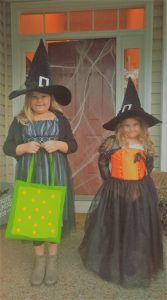
Happy Halloween!
by pmdavis | Oct 4, 2017
As part of National 4-H W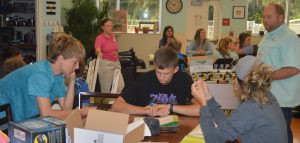 eek, 4-H’ers participate in 4 H National Youth Science Day (NYSD), the world’s largest youth-led science experiment. This year’s 4 H NYSD event will take place on October 4. The 2017 4‑H National Youth Science Day Challenge is called Incredible Wearables! This year’s challenge was developed by University of Nebraska-Lincoln and incorporates the fast-evolving field of wearable technology, teaching kids to not only use technology but to create it and understand how it works.
eek, 4-H’ers participate in 4 H National Youth Science Day (NYSD), the world’s largest youth-led science experiment. This year’s 4 H NYSD event will take place on October 4. The 2017 4‑H National Youth Science Day Challenge is called Incredible Wearables! This year’s challenge was developed by University of Nebraska-Lincoln and incorporates the fast-evolving field of wearable technology, teaching kids to not only use technology but to create it and understand how it works.
From watches and eyewear to fashion and virtual reality headsets, wearable technologies are fast becoming the must-have accessory for forward-thinking people around the world. Wearable technologies didn’t start out as trendy however – one of the world’s first wearable technologies was the hearing aid! Wearable technologies are now used in industries around the globe, from education and sports, to health, fashion, entertainment, transportation and communication. In this year’s challenge, youth use the engineering design process to build a prototype wearable technology that will gather data to help solve a real-world problem. They will design and build their own low-cost wearable health monitor following the engineering design process. This process includes defining the problem, designing and building prototypes (solutions) then systematically testing and evaluating enabling them to redesign for optimization of wearability and functionality.
During the innovative, hands-on project, these future engineers must work together to design, build and refine a wearable health-tracking device that is easy-to-use and aesthetically appealing. In fact, youth from Bay County have been training with their adult leaders to teach this challenge to other youth in their community on National Youth Science Day. Jason Scott, from Scott Innovative Solutions and an engineer at NSA PC, teamed up with the Bay County 4-H Agent to teach youth and adult partner teams about this project enabling them to be able to share their knowledge with others on October 4. When participants will attempt to solve the problem of people not staying active enough to lead healthy lives. In fact, youth will build a prototype fitness tracking device that could ultimately be marketed and sold to consumers to positively affect fitness behaviors.
After completing the challenge youth will have had an experience of using the engineering design process to build a device to help them monitor their health so they can gather data to make better decisions. They will understand more about how wearable technologies like FitBits, Smartwatches and other wearable devices are made.
The field of wearable technologies continues to grow in both quantity and quality. New technologies are being developed and put on the market on a regular basis, including virtual reality and augmented reality devices, clothing and accessories, as well as health monitoring devices. The future of wearable technologies is limited only by the imaginations of those designing them. By studying STEM and participating in this National Youth Science Day Experiment, youth could use technologies to develop products and mechanisms we haven’t even thought of, but definitely desire! To find out more information about other 4-H programs like this or volunteer your time to work with youth, contact your local UF IFAS County Extension Office or visit http://florida4h.org.
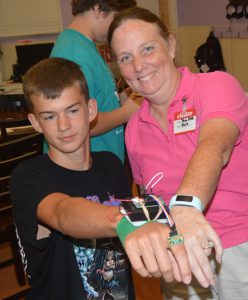
Comparing device to prototype
by bestevez | Jun 24, 2017
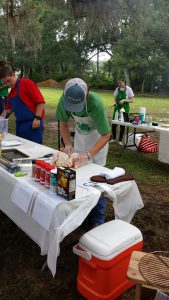
This contest teaches youth about meat science, food safety and communication skills.
Tailgating. The smell of charcoal in the air. Cooking over a hot grill. Earning lots of scholarship money?
The Florida 4-H Tailgate Contest completed its first year in 2016, giving out over $15,000 in scholarship money to 4-H members. This was made possible by sponsorships from Winn-Dixie, National Beef, and Sonny’s. In 2017, Sanderson Farms joins the list of sponsors for this statewide event.
While earning scholarship money is great, youth also learn many valuable life skills in the art of grilling. A curriculum series was developed (see below) to help youth learn about fire-building, meat selection, cooking safety, smoking and slow cooking meat, and cooking equipment. The Northwest District has been very proactive in hosting different tailgate and grilling day camps throughout the panhandle to further youth learning.
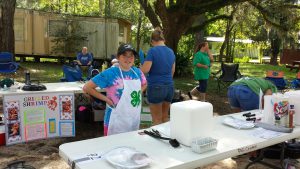
Youth demonstrate their knowledge during the district and state contests, and can win a college scholarship.
The Florida 4-H Tailgate Contest allows youth to grill two 6-8 ounce portions of one of the following proteins: beef, pork, poultry (half chicken or turkey breast), and headless, deveined, fresh shrimp. At each contest, judges will observe the food and fire safety of each participant and ask students questions about their recipe and safety knowledge. A team of judges will then evaluate the cooked product.
There are four contests hosted throughout the state including the South contest at 4-H Camp Cloverleaf, the Central contest in Dade City, the Northeast contest at the UF Horse Teaching Unit, and the Northwest contest held at the Washington County Fairgrounds. After youth compete at the local county contests/day camps, they can register for the district contest. The Northwest contest will be held on July 22, where the first place winner in each protein category receives $400, second place $250, third place $100, and fourth place $50. The top two winners from each protein area at the district contest are then eligible to compete in the state contest held at the University of Florida on October 14, 2017. For the state contest, the first place winner in each protein area receives a $1,500 college scholarship and the second place winner receives a $1,000 college scholarship.
We hope to see you at one of the many grilling opportunities offered throughout the Northwest District this summer through 4-H!
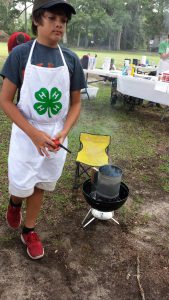 Day Camp Dates and Locations:
Day Camp Dates and Locations:
- June 5-9- Bay County Extension Office, Panama City, FL
- June 27-29-Holmes County Extension Office, Bonifay, FL
- June 27-29-Leon County Extension Office, Tallahassee, FL
- June 27-29-Liberty County Extension Office, Bristol, FL
- June 27-29-Washington County Extension Office, Chipley, FL
- July 5-6-Escambia County Extension Office, Cantonment, FL
- July 10-12-Walton County Extension Office, DeFuniak Springs, FL
Contact your local UF IFAS County Extension Office to inquire about other Florida 4-H Tailgating Day Camps and to register for the District Contest. For more information, visit these sites:
 DID YOU KNOW that the sunniest place in Florida is Apalachicola? It sees an average of 241 days with sun…just one of the many reasons I love calling the Florida panhandle my home. I’m not exaggerating when I say I love being outdoors in the sun – going to the lake, fishing in the bay, kayaking down the creek, mowing the grass, picking blueberries, reading a book – I don’t want to imagine living anywhere else.
DID YOU KNOW that the sunniest place in Florida is Apalachicola? It sees an average of 241 days with sun…just one of the many reasons I love calling the Florida panhandle my home. I’m not exaggerating when I say I love being outdoors in the sun – going to the lake, fishing in the bay, kayaking down the creek, mowing the grass, picking blueberries, reading a book – I don’t want to imagine living anywhere else.








